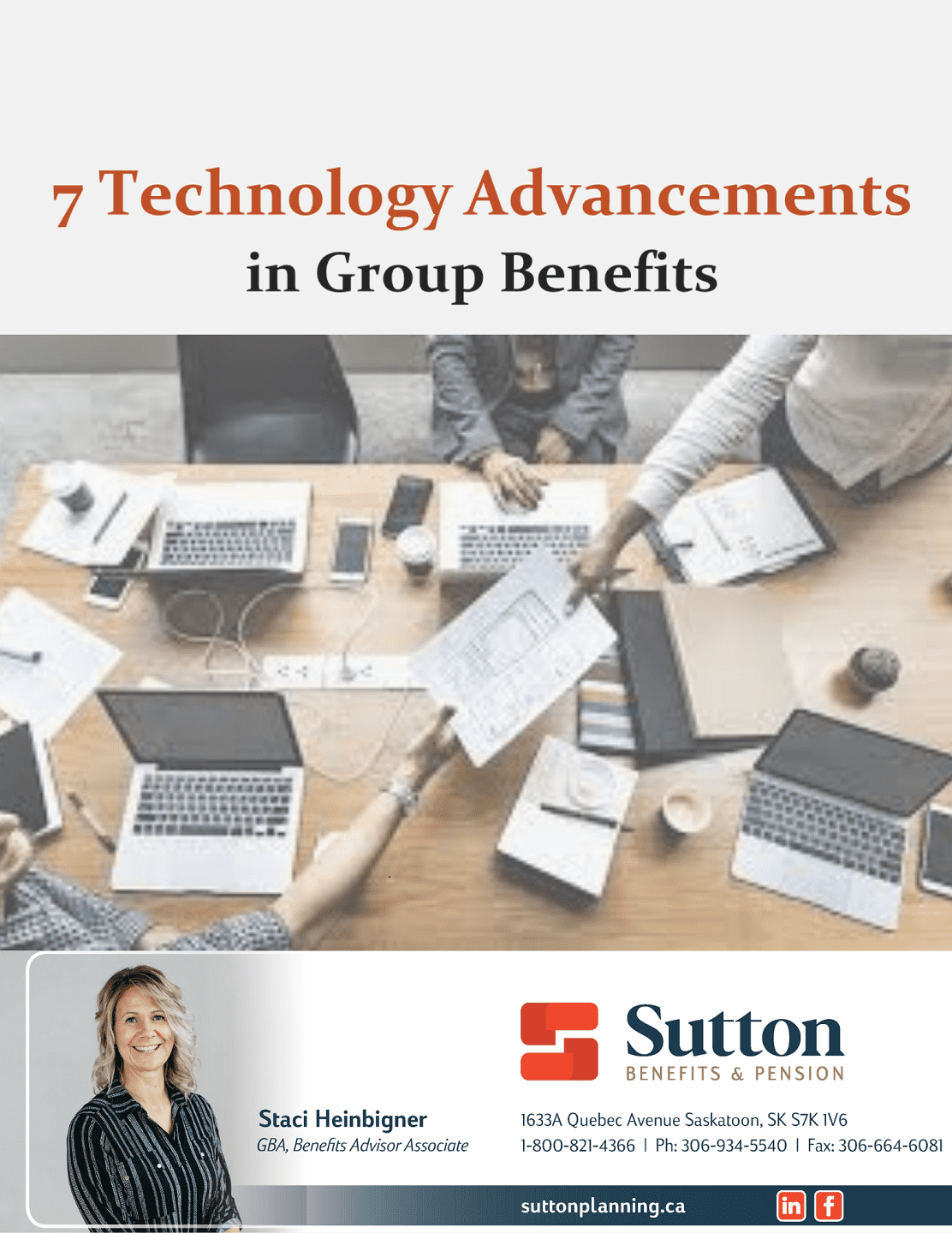We all seem to have a desire for instant gratification and the need to access the world at our fingertips. Have you ever watched Netflix, ordered food through Skip the Dishes or arranged a ride through Uber? Not only do we have instant access to things like entertainment, food, and transportation, but technology has been evolving in Group Benefits Plans to meet these new demands as well. Whether you have just implemented a benefits plan as part of your organization’s total rewards strategy or whether you’ve had one for years, consider how these 7 technology advancements could reshape your plan for today’s employees.
1. Online claim submission, reimbursement, and provider e-claims
Do you remember paying up front for all your services that were covered by your plan? And then that tedious process that followed… completing your claim form and gathering all of your original receipts so you could submit it all by mail? At times, I remember wondering if my claims even made it there because it always took so long to receive the reimbursement cheque back in the mail.
Great news. The process is much different now. It’s fast and simple. All your employees have to do now is show them their policy and plan numbers on their app and their care providers can directly bill the insurance provider electronically. More and more professional practitioners such as dentists, physiotherapists, optometrists, massage therapists and more, are making this available. Depending on the provider and your plan, you may not even have to pull out your wallet when you visit your care provider. There are pharmacies worldwide that now accept pay-direct drug cards. How wonderful is it to pick up your prescription at the pharmacy, show your pay-direct drug card and pay only your portion?
Everybody has to be able to participate in a future that they want to live for. That’s what technology can do.
– Dean Kamen
Where care providers have not arranged for direct billing and your employees need to pay for treatment up front, they can expect reimbursement to their bank account sometimes as quickly as 48 hours after an online claim submission.
Healthcare and wellness spending accounts have also advanced using a standalone app that allows a seamless, CRA-adjudicated, completely confidential process for employees to make claims.
Employees find more value in their benefits plan because out-of-pocket expenses have been drastically reduced. Employees can make claims with more ease and privacy now than ever before.
2. Online administration
Online benefits plan administration has changed benefits management for two groups of people.
- Plan Administrators. Thanks to advances in technology, employers and plan administrators can access benefits and pension plan information on demand, enabling them to provide timely resources and responses to employees’ questions. Administrators now have faster, easier access to billing statements and can make prompt updates to banking information, addresses and beneficiaries. Salary changes can also be processed as they happen so they can be kept current and won’t get missed or forgotten.
- Employees. Online administration has empowered employees to take control of their benefits plan. With easy access to their employee booklets, they can check their level of coverage before incurring an expense. They can see their available plan maximums whenever they choose and can even make changes to as needed including updates to banking information for direct deposit.
3. Online employee enrollment
With the help of advanced technology, a once largely paper-based and time consuming task has become a faster, more efficient process. Technology has helped to standardize processes, reduce errors and enhance reporting capabilities in benefits administration.
One of the most common – and most frustrating – administration errors is when an employee enrollment is submitted late. Not only is a “late applicant” difficult to navigate, but it can also potentially put the employer in a liability situation.
Most insurance carriers allow employees to be added electronically, skipping the paper application form altogether. Plan administrators can add employees upon hiring and then let the system activate the benefits once the waiting period has been fulfilled. Plan administrators can see at a glance who is on the plan and what is pending or outstanding. Enrollments won’t get forgotten and extra billing will be prevented.
More and more companies are beginning to embrace the online self-service portals available through benefit platforms. This enables employees to enroll themselves, make updates to their own personal information and have access to their company benefits information. This reduces the time that management needs to spend on plan administration, freeing them to focus on more strategic pursuits and realize cost savings in time and efficiency.
4. Telemedicine
Telemedicine is a tool that makes healthcare more accessible, cost effective, and that increases patient engagement. Since making its debut in the late 1950’s, advances in technology have made telemedicine available long distance and on-demand via secure text or video chat, 24 hours a day, 365 days a year.
Telemedicine provides access to licensed physicians for a range of services from a prescription refill to a medical diagnosis. It is a complement to our benefit plans, helping employees resolve their healthcare needs while redirecting them from unnecessary emergency department visits, decreasing the spread of contagious diseases in crowed waiting rooms and reducing long wait times of doctors’ offices. Initially, telemedicine was a standalone product that businesses could add to their total rewards package. It didn’t take long for major insurance carriers to build this service into their base plans when covid-19 began to spread, but statistics prove that telemedicine is not just a pandemic fad. It will largely dictate the future of healthcare.
5. Employee family assistance programs
Employee assistance programs have been around for many years. But over the past few years they have advanced their technology offering to employees. Employee family assistance programs are confidential and provide a range of services including short-term professional counselling, family support services, legal support services, financial support services, nutritional services, health coaching, specialized counselling and on-line programs.

Similar to telemedicine, an employee family assistance program can now be accessed in a number of ways including in-person sessions, by phone, on-line live chat, e-Counselling, video counselling, and text-based resources for self-directed support. Many also provide apps for mobile access to services from anywhere.
Considering that in any given year, one in five Canadians experience a mental illness or addiction problem and one in two Canadians will have – or have had – a mental illness by the age of 40, access to things like stress management, crisis counselling and online cognitive behavioural therapy for the treatment of depression or anxiety whenever and wherever is one of the greatest gifts of technology.
If you go back a few hundred years, things we take for granted today would seem like magic – being able to talk to people over long distances, to transmit images, flying, accessing vast amounts of data like an oracle. These are all things that would have been considered magic a few hundred years ago.
– Elon Musk
6. Employee Communication
Communication continues to look very different in the workplace. The days of communicating through a memo, sending information through a fax or sending a cheque through the mail are being seen less and less. Even phone calls and emails are becoming outdated with the rise of video conferencing and instant messaging. But the key piece here, is that technology allows for almost constant feedback and availability.
Often, decisions are made with the best of intentions, but sometimes we forget to consult the people the decision affects. “If it’s about me, ask me!” Getting feedback and insight from employees, either through an electronic survey, your business communication platform or a good old-fashioned conversation, can provide great insight before you invest time, money, energy and resources in expanding or changing your benefits program or developing new initiatives.
And don’t forget … continuous communication with your employees about benefits is critical. Educating your employees about your group benefits plan increases their understanding and utilization of their benefits. It reminds them of the value of their benefits and it gives them peace of mind that their needs will be taken care of if the unexpected happens.
7. Benchmarking tools
Understanding your position in the marketplace and how it aligns with your goals and priorities is a critical step in customizing your benefits plan design to achieve desired results.
 Do you ever wonder how your benefits plan stacks up against your competitors’? Group benefits plans used to be considered a perk. Now, they’re more like a requirement to attract new recruits. But a basic “cookie cutter” plan doesn’t get the job done either. It matters how comprehensive your plan is. What does it have to offer? Is it meaningful and aligned with your company mission?
Do you ever wonder how your benefits plan stacks up against your competitors’? Group benefits plans used to be considered a perk. Now, they’re more like a requirement to attract new recruits. But a basic “cookie cutter” plan doesn’t get the job done either. It matters how comprehensive your plan is. What does it have to offer? Is it meaningful and aligned with your company mission?
Benchmarking tools allow your advisor to compare your existing plan with those of your competition. Where are you strong? Where do you fall short? Can you reallocate some of your resources to make sure your investment really counts?
I anticipate that technological trends will continue influencing the ways in which employees view and consume their employee benefits and the way plan administrators execute the management and administration. Advancements in technology such as benchmarking and the incorporation of employee feedback will make a plan administrator’s work more data-driven, allowing them to be the most competitive in attracting and retaining top talent while identifying areas where cost reductions can be made.


